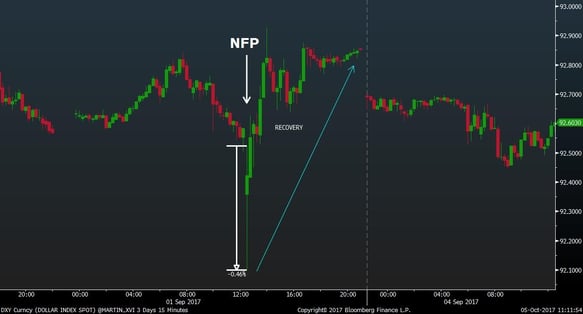U.S. Non-Farm Payrolls being released Friday at 14:30
Friday is jobs day in the U.S.—with the Non-Farm Payrolls being released at 14:30 in South Africa. The results will set the trading tone for next week and inject some volatility into the currency market.
Hurricanes Harvey and Irma could put a spinner on things but other indicators reveal an economy that appears to be firing. Hurricane Harvey battered the Houston area in late August and Irma tore through Florida in early September. The hurricanes affected the petroleum industry in particular, with oil refineries being shut down.
Private payroll processor ‘ADP’ announced on Wednesday that private businesses added 135,000 jobs in September following the two storms.
A panel of surveyed economists on Bloomberg expect that NFP data on Friday will count just 80,000 by the private and public sectors, down from an average 176,000 during the first 9 months of the year.
Non-farm payroll numbers will differ from the ADP data because it counts people as employed only if they are paid in a given week, while ADP numbers are included as long as the worker has been included in the payroll.
ADP attempts to forecast the NFP total but often varies from it significantly. Over the past 11 months, ADP’s initial estimate has been off by an average 53,000, up from 42,000 the previous 11 months
In September, ADP said, small businesses were the most impacted by the storms, losing 7,000 jobs. Medium sized companies added 63,000 jobs and large firms, 79,000
However, there is a bright spot - average hourly earnings are expected to rise by 0.3%, a significant improvement over the 0.1% from a month earlier.
The impact from the hurricane season will mean that this report has limited implications for Federal Reserve’s (Fed) policy, since the disruptions will last only one month. At least the rise in wages means that the Federal Open Market Committee (FOMC) remains on track for another rate increase in December, having signalled in September that it remained determined to push on with more increases in 2018 as well
What happened last time:
- August NFP: 156K vs. 180K expected
- July NFP: downgraded from 209K to 189K
- June NFP: downgraded from 230K to 210K
- Average hourly earnings (m/m): 0.1% vs. 0.2% expected
- Unemployment rate: ticked higher from 4.3% to 4.4% vs. 4.3% expected
- Labour force participation rate: unchanged at 62.9%
A net of 156,000 jobs were created for the month, weaker than the expected 180,000 increase and the 209k added in July. Even worse, both June and July’s numbers were DOWNGRADED to reflect a net decrease of 41,000 jobs for both months. Eish.
A closer look didn’t make the picture look prettier. The unemployment rate ticked higher from 4.3% to 4.4% even as the labour force participation rate remained at 62.9%. Unemployed workers rising by another 151,000 to 7.1 million might have something to do with it.
Meanwhile, average hourly earnings only grew by 0.1% when analysts had expected a 0.2% uptick.
(AUGUST NFP REPORT CHART)

Source: Bloomberg Dollar Index 15 Minute Chart
Some point to the intraday reversal as investors merely shrugging off the weakness in favour of pricing in a potentially hawkish FOMC.
Not surprisingly, the dollar dropped lower at the report’s broad weakness. The move didn’t last long, however, as the Greenback soon regained its losses (and then some) by the end of the day.
What can we expect this time?
- Non-farm payrolls: 80K vs. 156K previous
- Unemployment rate to steady at 4.4%
- Average hourly earnings (m/m): 0.3% vs. 0.1% previous
Market players only expect that a net of around 80K jobs were created in September, down from August’s 156K uptick.
I beleive that the FOMC will recognise this as a once-off event, and will stick to their strategy of reducing their balance sheet/culling monetary easing and increasing interest rates.
Moving beyond the headline numbers, the recent turn up in US data, which has supported a recent rally should provide further strength to the US dollar (USD). Therefore, a weak outcome could be another opportunity to buy the dip and go long USD.
The basics of what to look for:
An upside surprise form NFP may cause the U.S. dollar to rally. Alternatively, the dollar might slip on weaker NFP results.
A NFP that exceeds expectations, combined with higher hourly earnings would give the US Federal Reserve a good reason to increase interest rates more aggressively for inflation targeting purposes.
The expectations of higher interest rates could see the greenback firm against other major currencies – keep an eye on USD/JPY, EUR/USD and GBP/USD.
What is the Non-Farm Payroll?
The NFP report is treated as a key economic indicator for the United States. The NFP is considered the most comprehensive employment number released – as it represents 80% of the U.S workforce.
NonFarm Payrolls are reported on the first Friday of the month, whereby the number of additional jobs added from the previous month is released. The report contains valuable insights into the labour force that have a direct impact on the stock market, the value of the U.S. dollar and the price of gold.
The reason why farmers are excluded from employment figures is due to the seasonality in farm jobs.
The Strategy:
There are multiple ways of trading the NFP report; there are 3 basic strategies to be aware of:
- Traders who take a position early, before the data is announced, in anticipation for the directional movement the event will cause.
- Traders who take a position as the data is announced, hoping to scalp a quick profit off the volatility created by the data, be it negative or positive.
- Traders may wait for the market to digest the significance of the results, and after the initial swings have occurred, take a position on the side of the dominant momentum.
Trading Products Affected:
The NFP report affects major currency pairs as well as U.S. market index futures. Traders should take note of:
- GBPUSD
- JPYUSD
- EURUSD
- MEXICAN PESO
- S&P500 Index
- Wall Street Index
- Gold
- VIX









